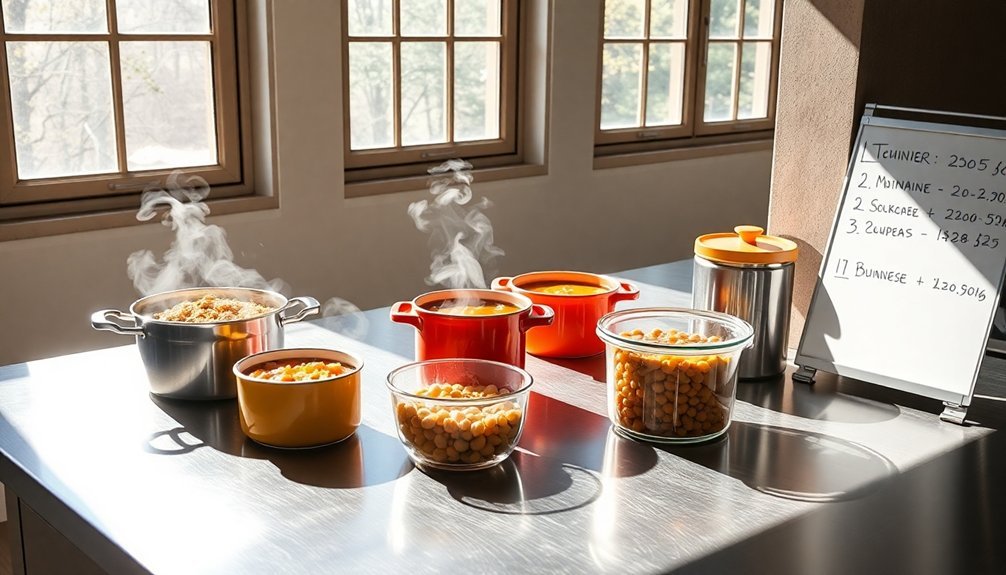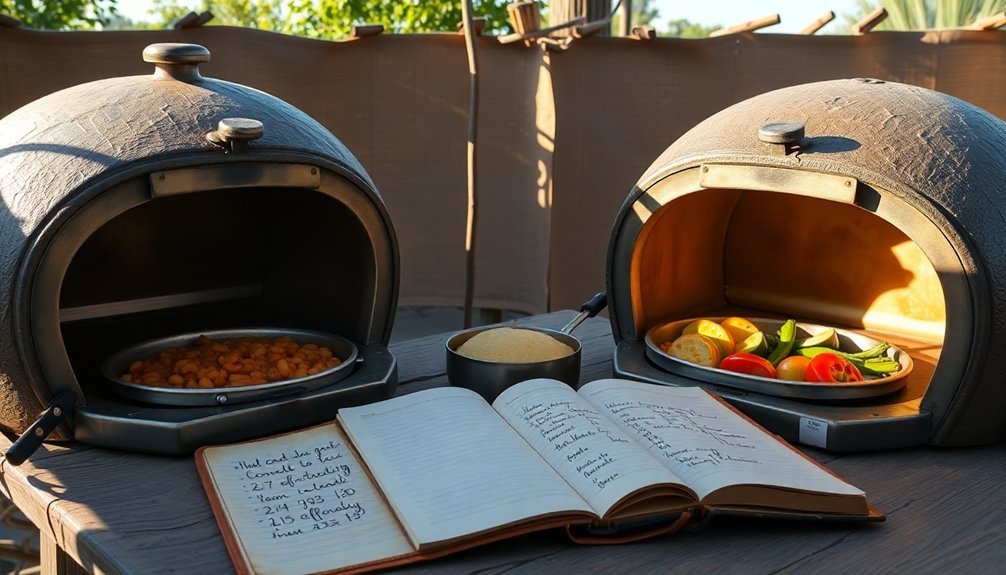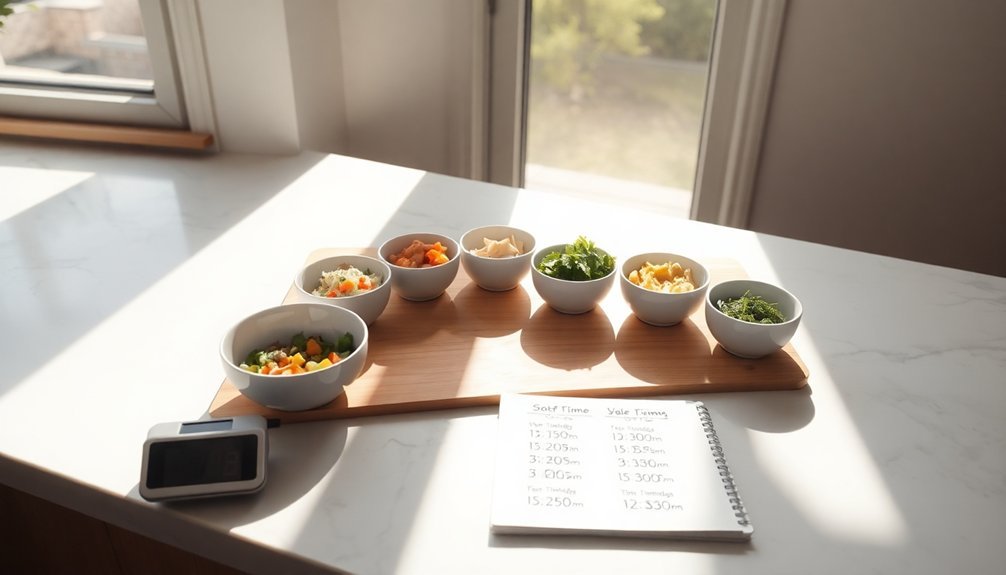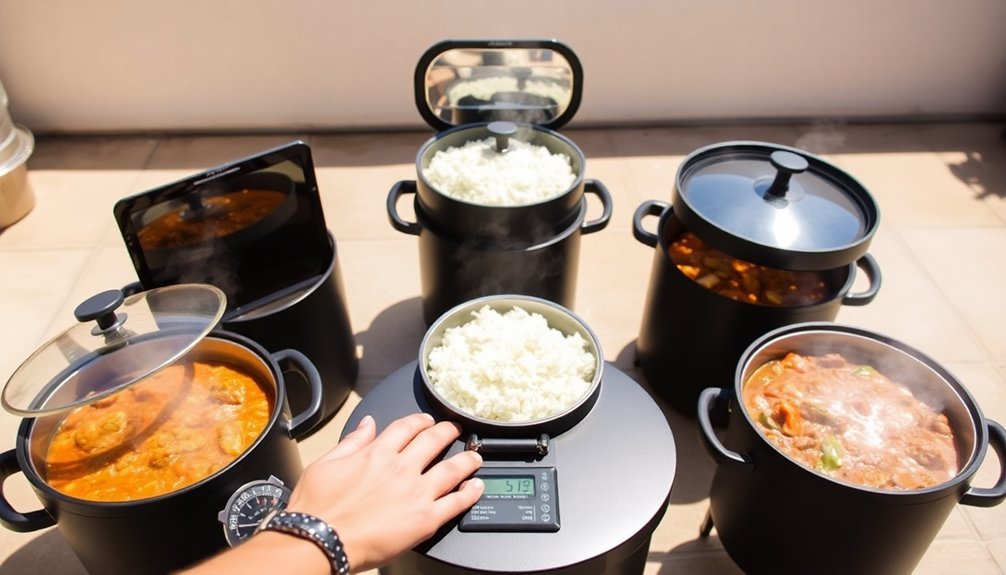To master multiple dish timing with solar cooking, you'll need to strategically plan your meal prep around peak sun hours (10 AM – 2 PM). Start long-cooking dishes early, positioning your cooker facing south, and use dark cookware for ideal heat absorption. Stagger your dishes based on cooking temperatures and times, setting up labeled cooking stations to stay organized. You can simultaneously prepare sides while main dishes cook – just remember to adjust your cooker every 1-2 hours for direct sunlight exposure. Clean during simmering periods to maintain workflow, and keep a weather app handy. Understanding these fundamentals will open up a world of sun-powered culinary possibilities.
Planning Your Solar Menu Schedule

When planning your solar menu schedule, selecting the right equipment and recipes makes all the difference. Start by choosing dark-colored cookware that'll absorb sunlight efficiently, and opt for recipes that work well with extended cooking times, like stews and slow-cooked meats. Just as in BEAM robotics projects, environmental sensing plays a crucial role in optimizing your setup's performance.
You'll need to track the sun's movement throughout the day, adjusting your cooker every one to two hours to maintain direct sunlight exposure. Position your solar oven facing south during peak sunlight hours, typically between 10 am and 2 pm.
Remember that most dishes take two to four hours to cook on sunny days, so prep ingredients in advance to maximize efficiency. Consider weather variables and have backup plans ready – cloudy days will require longer cooking times, while clear skies offer ideal conditions for multiple-dish preparation.
Understanding Solar Cooking Temperature Zones
Successful solar cooking depends heavily on understanding temperature zones within your cooker.
Different types of solar cookers offer varied temperature ranges, with box ovens reaching 160°F to 400°F and parabolic models soaring up to 800°F. You'll need at least 180°F for food safety.
To maintain consistent cooking zones, you'll want to preheat your cooker above 180°F before adding food.
Use dark cookware to maximize heat absorption and monitor temperatures with a reliable thermometer. Utilizing thermal mass materials like stones or bricks can help stabilize cooking temperatures.
Position your cooker between 11:00 AM and 3:00 PM for ideal results, adjusting it every 20-30 minutes to follow the sun.
Remember that seasonal changes affect your cooking zones.
You'll need more frequent adjustments in winter, while summer offers longer periods of stable temperatures without repositioning.
Staggering Dishes Throughout The Day

Managing multiple dishes in solar cooking requires strategic timing throughout the day. Start with long-cooking dishes early when the sun rises, then use the peak sunlight hours for dishes that need intense heat.
You'll need to set up different cooking stations and label each dish to avoid confusion. Clean as you work to maintain an organized workspace.
During simmering or waiting periods, you can prep ingredients for your next meal. The even cooking distribution provided by solar cookers helps maintain consistent results across multiple dishes. Remember to adjust your timing based on sunlight intensity and weather conditions.
Make the most of peak sun hours for demanding dishes, and save quick-cooking meals for later in the day. Always leave buffer time between dishes to handle any unexpected delays in cooking times.
Maximizing Available Sunlight Hours
To get the most from your solar cooking experience, understanding how to maximize available sunlight hours is essential. You'll achieve the best results by cooking during peak sun hours – typically two hours before and after solar noon when the sun is highest.
Position your oven so the sun will be directly in front of you halfway through your cooking time, and use the shadow test: if your shadow is shorter than your height, conditions are right for solar cooking. Most regions can achieve suitable cooking conditions for 4-6 months of the year.
Key strategies for ideal sun usage:
- Monitor your oven's internal temperature and adjust positioning accordingly
- Focus on cooking your main dishes during peak hours when temperatures can reach up to 400°F
- Minimize heat loss by keeping the oven closed and using dark, heat-retaining cookware
Remember to refocus your oven periodically, especially during longer cooking sessions or when clouds appear.
Organizing Your Cooking Space

Your success with multiple dishes hinges on smart kitchen organization, starting with dedicated zones that maximize prep surface area while keeping equipment within arm's reach.
Set up your solar oven in a spot that gets consistent sunlight throughout your planned cooking window, ideally near your main prep area but not blocking valuable counter space.
Create equipment access zones around your primary work triangle, ensuring frequently used tools and ingredients are positioned where you'll need them most.
Maximize Prep Surface Area
When cooking multiple dishes, a well-organized prep surface becomes the command center of your kitchen. To maximize your workspace efficiency, invest in a large cutting board that can accommodate multiple ingredients at once.
You'll streamline your workflow by grouping ingredients that'll be used together, keeping your prep organized and your timing on track.
- Set up small prep bowls near your cutting board to hold prepped ingredients if space is limited, making it easy to grab what you need when it's time to cook.
- Keep frequently used ingredients like onions and garlic within arm's reach to minimize movement during busy cooking sessions.
- Position your prep station adjacent to your cooking zone, allowing for smooth shifts between chopping and cooking.
Remember to clear clutter regularly and maintain an organized prep surface to guarantee efficient multi-dish preparation.
Solar Oven Placement Strategy
Since solar cooking requires precise positioning and timing, proper placement of your solar oven becomes essential for successful meal preparation.
Set your oven on a level surface between 11 AM and 3 PM, when sunlight is strongest. Point the shorter front panel east for lunch or west for dinner, and track the sun by repositioning every 20-30 minutes.
You'll know you've achieved ideal alignment when the oven's shadow falls directly behind it. During winter, start cooking earlier around 10 AM.
Combat wind challenges by anchoring your oven with stones and using protective barriers. Create an air gap under pots with a wire rack to enhance heat retention.
Keep reflectors clean and properly angled, and use dark cookware to maximize heat absorption. Adding bricks or stones around pots helps maintain stable temperatures.
Equipment Access Zones
Efficient kitchen organization starts with establishing distinct equipment access zones that streamline your cooking workflow. When preparing multiple solar-cooked dishes, you'll need quick access to your tools and equipment.
Create dedicated zones for preparation, cooking, cleaning, and storage to maintain smooth operations.
Your essential zones should include:
- A preparation area near your counter space with easy access to knives, cutting boards, and mixing bowls
- A cooking zone equipped with necessary utensils, pots, and pans adjacent to your solar cooking setup
- A cleaning station with immediate access to sinks and composting or waste disposal
Position your storage areas to complement these working zones. Keep your dry goods, refrigerated items, and non-consumables like dishes and cutlery organized but away from your main work areas to prevent congestion during meal preparation.
Backup Plans For Weather Changes
Because solar cooking relies heavily on weather conditions, you'll need robust backup plans to make certain your meal preparation stays on track.
Keep alternative cooking methods like gas stoves or charcoal grills ready, and maintain an adequate fuel supply for emergencies.
Monitor weather forecasts and UV indices to plan your cooking schedule effectively.
You'll want to focus your solar cooking during peak hours between 10 a.m. and 4 p.m., when sun intensity is strongest.
If clouds threaten your cooking plans, you'll need to adjust quickly. Use weather apps and pyranometers to measure solar irradiance and determine if conditions are suitable for solar cooking.
Don't forget to regularly calibrate your temperature sensors and maintain your solar oven.
This maintains peak performance when favorable conditions return.
Frequently Asked Questions
Can I Use My Regular Glass Bakeware in a Solar Oven?
You shouldn't use regular glass bakeware in your solar oven due to thermal stress risks. Instead, opt for dark metal pans or black cast iron cookware, which absorb heat better and won't risk shattering.
How Do Different Altitudes Affect Solar Cooking Times and Temperatures?
At higher altitudes, you'll get more intense solar radiation but lower boiling temperatures. You'll need to extend cooking times and adjust recipes since water boils at lower temperatures due to reduced atmospheric pressure.
What's the Best Way to Clean and Maintain a Solar Oven?
You'll need to clean your solar oven after each use with a soft sponge and soapy water. Regularly inspect for damage, maintain protective coatings, and keep reflective surfaces spotless to guarantee maximum cooking efficiency.
Can Solar Ovens Work Effectively in Winter Months?
Yes, you'll find solar ovens work well in winter with bright sunshine. Clear, cold days can actually provide intense sunlight. Just guarantee you've got good insulation, direct sun exposure, and shelter from wind.
Should I Adjust Ingredient Quantities When Converting Traditional Recipes for Solar Cooking?
Yes, you'll need to reduce liquid ingredients by about half when adapting traditional recipes for solar cooking. Foods cook in their own juices, so using too much liquid can make dishes overly moist.
In Summary
You'll find solar cooking timing becomes second nature with practice. Keep your recipes organized, understand your solar cooker's temperature patterns, and plan dishes strategically throughout the day. Don't forget to check weather forecasts and have backup options ready. Remember, you're working with nature's schedule, so flexibility is key. With these skills mastered, you'll confidently prepare complete solar-powered meals for any occasion.





Leave a Reply